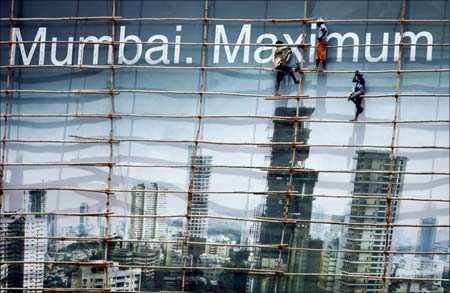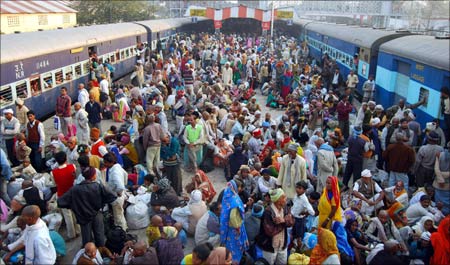Photographs: Arko Datta/Reuters
Uttar Pradesh tops the list of states from where the largest number of migrants come to Maharashtra in search of employment.
During the last five years, of the 12.39 lakh (1.239 million) people who have migrated from other states to Maharashtra, 4.23 lakh (423,000) are from Uttar Pradesh, as per the Economic Survey of Maharashtra for 2008-09 which was tabled in the state Legislature on Wednesday.
Text: PTI
UP tops list of migrants in Maharashtra
Image: Devotees wait to board a train, after taking a holy dip in the Sangam during the Magh Mela festival, at a station in Allahabad, Uttar Pradesh.Photographs: Jitendra Prakash/Reuters
According to the survey, 1.35 lakh (135,000) people came from Karnataka, 1.19 lakh (119,000) from Gujarat, 0.82 lakh (82,000) from Rajasthan, 0.51 lakh (51,000) from Bihar, 0.4 lakh (40,000) from West Bengal, 0.41 lakh (41,000) from Kerala and 0.32 lakh (32,000) from Andhra Pradesh.
Out of the total migrants, 10.74 lakh (1.074 million) have migrated to urban areas of the state.
UP tops list of migrants in Maharashtra
Image: An artist from Karnataka takes part in a religious procession.Photographs: Amit Gupta/Reuters
The survey also states that 22.62 lakh (2.262 million) people from rural areas in Maharashtra have migrated to various urban areas of the state, which has resulted in increased burden on infrastructure.
Search of employment (564,000) was the main reason for the migration from other states during the last five years, followed by migration of parents/earning members (385,000), marriage (202,000) and educational purpose (51,000).
The survey also said that the population with Marathi as a mother tongue has decreased from 76.5 per cent to 68.8 per cent during the last three decades.




article